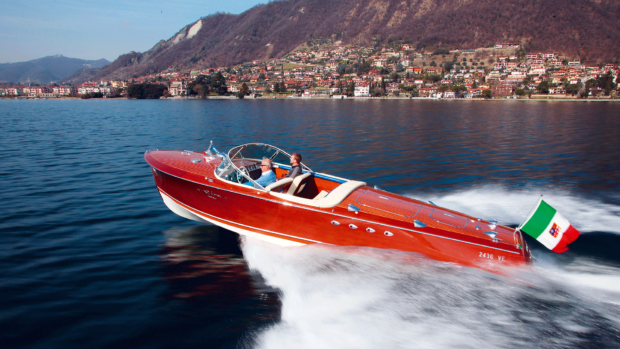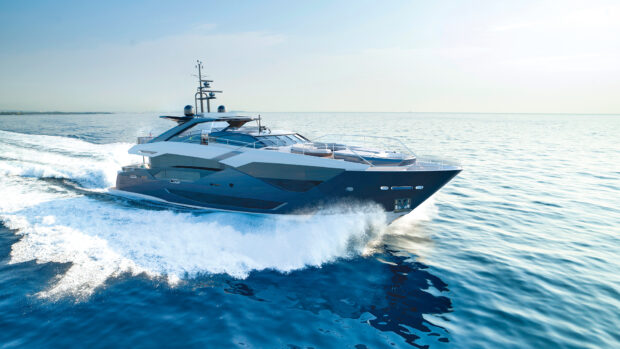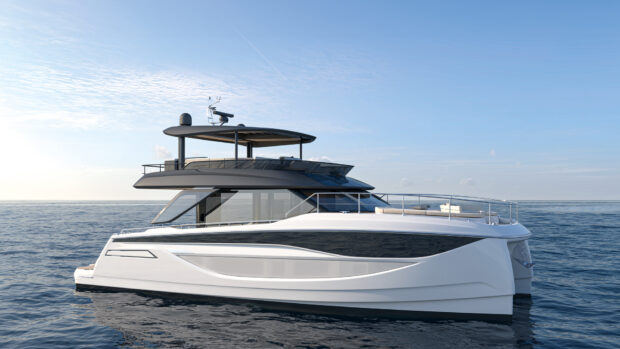Songwriter, presenter and serial boat owner Richard Stilgoe’s latest purchase is a solar-powered motor launch that is red and black and green all over…
When I was 70 I celebrated by going on a voyage with my children in my sailing boat. Now I am 80 I am going on a voyage with my grandchildren in a motor boat – a smaller voyage because the grandchildren are smaller (as am I) and a motor boat because after the last voyage my children told me I wasn’t to sail anymore because I was so bad at it!
One of the attractions of sailing is that you bend the elements to your will and use the wind to take you in directions the wind doesn’t want to go. Since this time I am not allowed to use the wind, I thought I would try and use the sun instead.
My last five boats (I know, disgraceful, but the hunt for a boat that will go round Cape Horn and still fit on a roof rack is a long one) have all been designed by Nigel Irens.
What Nigel is good at (apart from once reciting Marriott Edgar’s poem ‘The Lion and Albert’ in unison with me as we rounded Land’s End at midnight) is drawing slippery boats that move through the water without fuss, so use less energy. Ellen Macarthur found this to be true, and so have I.
Article continues below…

Nigel Irens classic boat tour: Beautiful wooden river launch with an electric motor

BMW launches new ICON electric boat at Cannes Film Festival
The Cannes Film Festival has seen the launch of the new ICON electric boat. Created by BMW in collaboration with
Slippery when wet
His latest creation is a 26ft (8m) motor launch called Clara. He is building a series of these – well, Rodney, Charlie and Aelfi are building them out of computer-cut marine ply – in Totnes.
They weigh less than a tonne and when powered by a modest petrol outboard can double their theoretical hull speed of 6.83 knots. Because of their uniquely efficient hull shape, they are also well suited to being driven by an electric outboard, in my case an ePropulsion Navy 6 (equivalent to 9.9hp).
An electric outboard? Hold on, you said you were using the sun. Be patient and all will become clear. My version of Clara has a canvas canopy. On this canopy are four flexible photo-voltaic panels, which use sunlight to produce a peak power output of 1kW of electricity that helps charge the batteries.

Faraday starts to take shape from pre-cut pieces of marine ply at the workshop in Totnes. Plywood was chosen as it is lighter and more sustainable than GRP
She is called Faraday, after the man who invented the electric motor. Also because, like the owner of an electric car, I worry about how ‘far a day’ she can go.
Look at the photos and you might also notice that the two sides of Faraday are different colours. Of course they are. She’s an electric boat. She has a positive side and a negative side. Do try and keep up!
My stipulation to Nigel was that my boat should have enough battery capacity to travel 70 miles at 7 knots so there are four big batteries, weighing 350kg and storing 36kWh between them.

A fine entry is key to Nigel Irens’ slippery hull design
These sit in the bilge to balance the weight of the solar panels on the roof – though these only weigh 21kg and the canopy is simply canvas on a light carbon fibre frame. I also set a more ambitious goal – to produce enough energy from the solar roof to push the boat along on sunny days without draining the batteries at all.
Initial calculations suggested that she would max out at 8.5 knots but using only 3kW she would happily go at seven knots – the speed of a fast sailing boat and with the same amiable sounds of wind and water rather than the angry hornet buzz of a petrol outboard.
On a fine day the solar panels should also produce 1kW of power. With nine hours of daylight that’s 9kW hours, enough for three hours of 3kW motoring. Could it really be that easy?

Red on port side and black on starboard side represent the positive and negative colours of its electric drivetrain
To put the theory to the test, we planned a shakedown voyage. This needed to be ambitious enough to test Faraday but not so ambitious as to test the grandchildren – with any luck it might actually be fun.
The plan was to travel from Tewkesbury to Stratford-upon-Avon over four days during the Easter holidays. The crew would comprise a timeshare collection of children, grandchildren and me.
Water music
When the time came, the Avon was in flood and we had to delay our planned departure date. Tewkesbury Marina, like most boat-related places, was staffed by an optimist and a pessimist. The pessimist said it would be at least a week before we could set off. The optimist said we could go the following afternoon. We went the next afternoon.
Like many boaters, I usually enjoy having a horizon on one quarter and a coastline on the other, or even a horizon all around, but with children onboard having a riverbank on either side keeps the pulse rate down and provides lots of stuff to watch and do.

Lightweight canvas canopy also carries solar panels
The paddles in the locks can be worked by young and old alike, and winding the winch handles and releasing a small tsunami into the lock is very satisfying – as is the moment when the lock is full, pressure above and below the gate is the same, and even a young child can move a huge chunk of Victorian engineering to open the way to the next stretch of river. The same small person can often instinctively steer the boat better than his supposedly experienced grandfather.
The other joy of river cruising is that you can stop in pretty towns and stay in pubs with bed-sized beds (as opposed to boat-sized bunks); we enjoyed the Angel Inn in Pershore, followed by a morning walk to the abbey, which displayed a sign saying ‘Total Silence – organ tuning in process’.
In the middle of the aisle was a brand new organ console with an Italian musician at the keyboard. He pressed a key and a small batsqueak was emitted by a high-up pipe. He nodded knowingly, said ‘Si’ and repeated the process, much to the amusement of us all.

Working the locks is all part of the fun for Richard and his crew of grandchildren
Silent light
Evesham on the eve of Good Friday provided us with a great Italian meal, during which the younger grandchildren fell asleep face down in their pizzas as if on a primary school stag weekend.
And Stratford was as exciting as Hong Kong harbour, with hundreds of novices spending their first day on the water rowing backwards in rented skiffs while we dodged silently between them. If Shakespeare had been sitting on the bank, The Comedy of Errors would have been re-written then and there.
Four days after setting off from Tewksebury, we tied up opposite the Shakespeare Memorial Theatre, where 30 years ago I had appeared on stage in front of a depressingly small audience.

We had covered 44 miles and been through 18 locks. We met one other boat, and only hit it a glancing blow. We crashed into a small tree. We averaged 4 knots, which is all you are allowed to go on the river, and, most satisfyingly of all, we set off with the batteries 100% full and arrived 44 miles later with the batteries still 100% full.
The 48 hours of daylight had produced enough electricity for the 12 hours of travel without recourse to shore power. Daylight – free, abundant daylight – had taken us all the way there, topping up the batteries as we went.
While we went about our business, Faraday went about hers so quietly and efficiently that nobody ever needed to raise their voice. The grandchildren didn’t really notice this quietness but they did notice that waterbirds came to investigate rather than flying away.

No need for binos on a silent electric boat as the wildlife come to you
They were also bright enough to grasp the daylight/electricity/power/no emissions equation. They come from a generation that is understandably obsessed with saving the planet and they enjoy Faraday being a tiny contributor to that cause.
What would I change about her? Hardly anything. I have known Nigel for years and he understands the relationship between water and floating objects as well as anyone since Archimedes. She feels right.
All I am going to do is remove the chemical loo I put in one of the lockers. Nobody used it, and I don’t think anybody ever will. As grown-ups have said for generations, you should have been before we set off.

Shakedown cruise complete and theory successfully proven, Faraday then travelled by trailer to her home mooring in Devon, where she now sits waiting for more adventures.
During the summer she and I will venture out on sunny days to Dartmouth, Newton Ferrers and possibly Plymouth. Because if the sun shines we now know there is no limit to how far a day Faraday can go.
First published in the July 2023 issue of MBY.
If you enjoyed this…
Be first to all the latest boats, gadgets, cruising ideas, buying advice and readers’ adventures with a subscription to Motor Boat & Yachting. Available in both print and digital formats, our monthly magazine will be sent directly to your home or device at a substantial discount to the usual cover price. See our latest offers and save at least 30% off the cover price.










